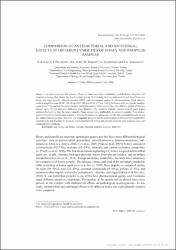Comparison of antibacterial and antifungal effects of different varieties of honey and propolis samples

View/
Access
info:eu-repo/semantics/openAccessDate
2020Author
Kolaylı, SevgiPalabıyık, İsmail Murat
Atik, Didem Sözeri
Keskin, Merve
Bozdeveci, Arif
Karaoğlu, Şengül Alpay
Metadata
Show full item recordCitation
S. Kolayli, S. Kolayli, I. Palabiyik, I. Palabiyik, D.S. Atik, D. Atik, M. Keskin, M. Keskin, A. Bozdeveci, A. Bozdeveci, & S.A. Karaoglu, S. Karaoglu. (0000). Comparison of Antibacterial and Antifungal Effects of Different Varieties of Honey and Propolis Samples. Acta alimentaria, 49, 515-523. doi: 10.1556/066.2020.49.4.18Abstract
Honey is the most important bee product. There are many secondary metabolites, carbohydrates, enzymes, and vitamins in honey, thus, honey has antimicrobial activity. in this study, in vitro antimicrobial activity of forty-two honey and eight propolis ethanolic extracts (PEE) were investigated against 16 microorganisms. Total phenolic content ranged between 20.00-124.10 mg GAE/100 g and 103-232 mg GAE/g for honey and raw propolis samples, respectively. Pine and oak honeydew honeys had higher antimicrobial activity than four different grades of Manuka Honeys up to 18 mm minimtun inhibition zone diameters. the ethanolic propolis extracts showed much higher antimicrobial activity than the honey samples. Fungi species were inhibited by the propolis samples. Helicobacter pylori( (H. pylorii) was the most sensitive, whereas Streptococcus agalactiae was the most resistant bacteria among the studied microorganisms. Brazilian and Zonguldak propolis had the closest antimicrobial activity to ampicillin, streptomycin, and fluconazole. It can be concluded that both honey and propolis could be used in preservative and complementary medicine.

















